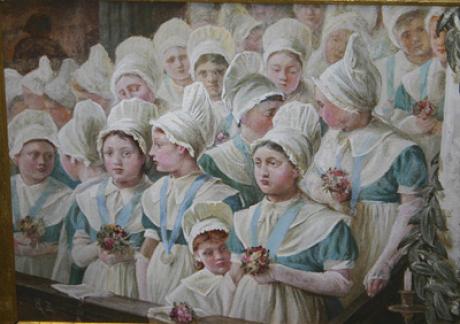initialled "EB" on the reverse and inscribed with title on the reverse
An Easter bonnet represents the tail-end of a tradition of wearing new clothes at Easter, in harmony with the renewal of the year and the promise of spiritual renewal and redemption.
The "Easter bonnet" was fixed in popular culture by Irving Berlin, whose frame of reference was the Easter parade in New York City, a festive walkabout that made its way down Fifth Avenue from St. Patrick's Cathedral:
In your Easter bonnet
with all the frills upon it,
You'll be the grandest lady in the Easter parade.
At the depths of the Great Depression a new hat at Easter, or a refurbished old one, was a simple luxury.
The broader English tradition of new clothes at Easter has been noticed in late 16th century references by Peter Opie, who noted Mercutio's taunting of Benvolio in Romeo and Juliet: "Did'st thou not fall out with a Tailor for wearing his new Doublet before Easter?" At just the same time Thomas Lodge's moralising pamphlet Wits Miserie (London, 1596) recorded "The farmer that was contented in times past with his Russet Frocke & Mockado sleeues, now sels a Cow against Easter to buy him silken geere for his Credit". In Samuel Pepys' diary, 30 March (Easter Day) 1662, he notes
Having my old black suit new furbished, I was pretty neat in clothes to-day, and my boy, his old suit new trimmed, very handsome.
Poor Robin, an 18th-century English almanac maker, offered the doggerel
At Easter let your clothes be new
Or else be sure you will it rue.
and the notion that ill-luck would dog the one who had not something new at Easter expanded in the 19th century.
Today the Easter bonnet is a type of hat that women and girls wear to Easter services, and in the Easter parade following it. Ladies purchased new and elaborate designs for particular church services, and in the case of Easter, taking the opportunity of the end of Lent to buy luxury items. Now, in a more casual society, Easter Bonnets are becoming harder to find, as fewer and fewer women bother with the tradition.
Modern Easter bonnets for children are usually white wide-brimmed hats with a pastel colored satin ribbon around it and tied in a bow. It may also have flowers or other springtime motifs on top, and may match a special dress picked out for the occasion.
Until recently, it was popular in infant school to ask a child to design an Easter-themed hat at that time of year. The aim was to get their parents to wear it to Easter services.
London watercolour painter of genre and decorative compositions using genre subjects; etcher and engraver, studied at the Birmingham School of Art, later in paris and Italy. Exhibited at the principle London galleries from 1866, mainly at the RWS and RA (1870-81), Elected ARWS 1878. Illustrated "For once a week" and was also on the original staff of "The Graphic". Gave instruction in art to Queen Alexandra and then the Princess of Wales.

